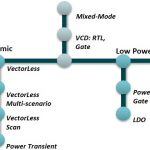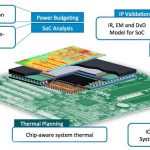In principle, one way to address variation is to do simulations at lots of PVT corners. In practice, most of this simulation is wasted since it adds no new information, and even so, important corners will get missed. This is what Sifuei Ku of Microsemi calls the British Museum Algorithm. You walk everywhere. And if you don’t walk to… Read More
Tag: 52dac
Why You Really Need Chip-Package Co-analysis
There’s only one software company that I know of that covers four major disciplines: Fluids, Structures, Electronics and Systems. That company is ANSYS and when they acquired Apache Design Automation back in 2011 they filled out their products for electronics design, and more specifically in the area of integrated chip-package… Read More
Designing an IDCT for H.265 using High Level Synthesis
Math geeks know all about Inverse Discrete Cosine Transforms (IDCT) and a popular use is in the hardware architecture of High Efficiency Video Coding (HEVC), also known as H.265, the new video compression standard and widely used in consumer and industrial video devices. You could go about hand-coding RTL to create an IDCT function,… Read More
Choosing C++ or SystemC for High Level Synthesis
Most engineers learn by doing, and so at DAC in June an EDA vendor with High Level Synthesis (HLS) tools held a language tutorial on choosing C++ or SystemC for design and verification projects. The EDA company is Calypto, and Stuart Clubb put together the tutorial on using synthesizable C++ or SystemC. The design and verification… Read More
Benefits of RTL Power Budgeting
Only one company at the recent DAC conference and exhibit had a set of four interacting disciplines: Fluids, Structures, Electronics and Systems. Did you guess that the company was ANSYS? I get so IC focused at times that I almost forget that chips plug into boards, that boards become systems, and that systems drive and control mechanical… Read More
Circuit Simulation Update from #52DAC
Actual users of circuit simulators told their design and simulation stories at DAC during a luncheon sponsored by Synopsys on June 8th. I always prefer to hear from a design engineer versus a marketing person about what tool they use for circuit simulation, and how it helps them analyze their design goals. This year there were engineers… Read More
Trends in Automotive Electronics at #52DAC
The coolest and most expensive car at DAC this year had to be the McLaren P1, priced at $1,150,00 and powered by a 903 hp gas/electric hybrid. Electronics are used in autos to provide safety features, infotainment, motor control and performance.
Also at DAC this year there was an Automotive Village with more cars and experts from … Read More
A Systems Company Update from #52DAC
On Sunday night at DAC we heard from Gary Smith that traditional EDA companies need to grow into new market segments in order to stay relevant, and that a systems-level approach to multi-disciplinary engineering was called for. I almost jumped out of my seat and said, “Hey, what about Dassault? They are already doing that … Read More
eSilicon ♥ ARM!
The things I enjoy the most at conferences are presentations by customers, the companies that solve the problems we face every day with modern semiconductor design. We all have access to the same tools and IP and use the same foundries so it’s the actual design and implementation that separates the wheat from the chaff, absolutely.… Read More
More about “MIPI beyond Mobile” Paper at DAC
The “MIPI Beyond Mobile” paper has been presented during the 52th DAC in San Francisco and I can share the key findings with Semiwiki readers. This paper has been written to synthesize certain results of the “MIPI Ecosystem Survey-2015” and evaluate the impact on the MIPI IP sales in the future. At first the MIPI Ecosystem has really… Read More







